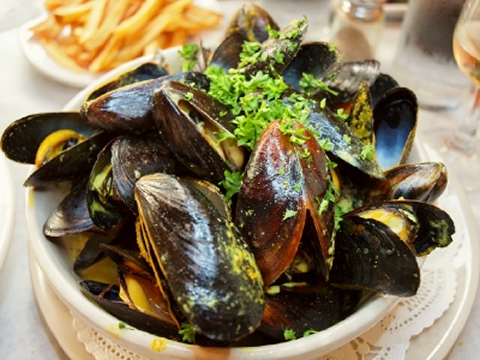
Our annual survey of seafood in Southeast Louisiana this year counts down the 33 best seafood species enjoyed in our restaurants, seafood markets, and homes. For the full survey so far, click here.
#12: Black Mussels
Mussels are closely related to oysters. They have bivalve shells, thinner and smoother than those of oysters. They hang on anything in the water that will hold them (including other mussels), and filter sea water for nutrients. The meat inside the shell looks like that of an oyster, just smaller, and a different color (the males are orange, the females a cream color). Unlike oysters, however, they're not especially good raw--either from a taste or health perspective.
The best mussels are the blue (almost black) mussels from both Atlantic coasts, where they grow in seemingly inexhaustible numbers. They are the ones that inspire the world's most avid mussel-eaters: the Belgians. They and the other people along the North Sea coast eat mussels the way Louisiana people eat crawfish: by the bucket. On our side of the ocean, the same mussels are at their best in New England and Canada, with Prince Edward Island being the most celebrated source.
We like oysters so much that it's strange we didn't embrace mussels sooner. It wasn't until about fifteen years ago that they became common on New Orleans menus. Before then, any chef who brought them in wound up eating them himself. Now mussels--steamed in their shells and accompanied by a pile of fresh-cut fries--are in every French bistro, and many other kinds of restaurants, too. The reason for the sudden appearance is that the bivalves are now cleaned well at the source, removing all the work of debearding from the cook. And, like lots of other seafood, they're shipped by air everywhere.
 As is true for oysters, there are many ways to prepare mussels. Most of the recipes involve steaming them in their shells in a pan of wine, lemon juice, savory herbs, and (sometimes) cream or tomato sauce. They cook very quickly, or should. That explains most of the problems restaurants have with mussels: they cook them so long that they shrivel down to nothing. And there's another reason for the many scrawny, overcooked mussels I find in some places. The quality of mussels varies wildly. Today they may be plump and perfect; tomorrow, there's almost nothing inside the shell. Despite that, many chefs cook, serve, and charge as if the mussels are at their peak.
Restaurateurs would prefer you didn't know that mussels are very, very cheap. A restaurant can make a profit selling three dozen of them for less than $20. Never accept fewer than a dozen for an appetizer of two dozen for an entree.
Unacceptable Alternative. Green-lipped mussels are well-named. The inside rim of the shell is an attractive iridescent green. These come from New Zealand and Thailand, almost always frozen, usually on just one shell (the dead giveaway). They are bigger than blue mussels, but distinctly less good--maybe because of the long shipping time. I'll get back with you when I can try them at the source.
As is true for oysters, there are many ways to prepare mussels. Most of the recipes involve steaming them in their shells in a pan of wine, lemon juice, savory herbs, and (sometimes) cream or tomato sauce. They cook very quickly, or should. That explains most of the problems restaurants have with mussels: they cook them so long that they shrivel down to nothing. And there's another reason for the many scrawny, overcooked mussels I find in some places. The quality of mussels varies wildly. Today they may be plump and perfect; tomorrow, there's almost nothing inside the shell. Despite that, many chefs cook, serve, and charge as if the mussels are at their peak.
Restaurateurs would prefer you didn't know that mussels are very, very cheap. A restaurant can make a profit selling three dozen of them for less than $20. Never accept fewer than a dozen for an appetizer of two dozen for an entree.
Unacceptable Alternative. Green-lipped mussels are well-named. The inside rim of the shell is an attractive iridescent green. These come from New Zealand and Thailand, almost always frozen, usually on just one shell (the dead giveaway). They are bigger than blue mussels, but distinctly less good--maybe because of the long shipping time. I'll get back with you when I can try them at the source.